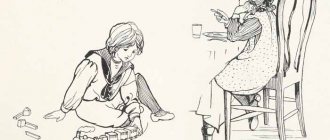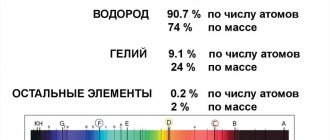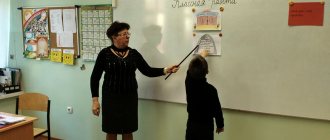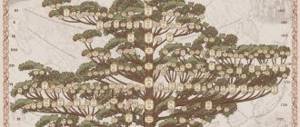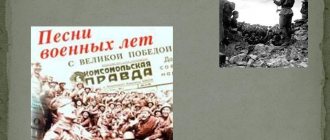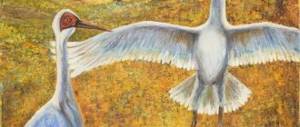Tchaikovsky "Children's Album" (presentation). presentation for a lesson on the topic
Slide 1
“Children’s Album” by Pyotr Ilyich Tchaikovsky Prepared by music teacher MKOU “School No. 10” of the Stupino urban district M.O.
Slide 2
Pyotr Ilyich Tchaikovsky (1840-1893) – great Russian composer and conductor. Born on May 7, 1840 in the city of Votkinsk in a large family. Music was often played in Tchaikovsky's house. His parents were fond of playing the piano and organ.
Slide 3
He grew up very kind and was afraid of offending or upsetting anyone. His nanny believed that Petya had a very generous heart. But he had one peculiarity: Petya loved to retire and listen to the sounds that were heard around him. The music that sounded inside the boy captured Petya more and more, and he began to sit down at the piano and select different melodies. So he began to compose music. To become a composer, Pyotr Ilyich graduated from the St. Petersburg Conservatory in 1866, where he studied composition.
Slide 4
Tchaikovsky died in St. Petersburg on November 6, 1893 from cholera. Pyotr Ilyich Tchaikovsky wrote fourteen operas, three ballets and numerous symphonic works. In addition to music for adults, he wrote many wonderful musical works for children and youth. The composer loved to travel, visited different countries and conveyed his impressions in music. He was not only a composer, but also an orchestra conductor, and also taught at the Moscow Conservatory.
Slide 5
The composition of "Children's Album" is the composer's first approach to a children's theme. The album is dedicated to the composer’s beloved nephew Volodya Davydov, a deaf-mute boy.
Slide 6
“Morning Prayer” The piece is an example of a musical expression of peace and sublime contemplation. In Soviet-era publications it received a different name - “Morning Reflection”. In the music you can hear the sound of a children's choir. The melody is created from living, as if speaking, intonations. The piano sound imitates the sound of a children's choir. In the music you can feel the shades of emotional unrest, the subtlest nuances of changing moods.
Slide 7
“Winter Morning” “Winter Morning” is the second piece from P. Tchaikovsky’s piano cycle “Children’s Album”. P. Tchaikovsky conveyed the subtle atmosphere of a winter morning with his piano sound. The flow of the melody is very natural and therefore easy to remember. The play is an example of a harmonious three-part musical form, in which the middle part is marked by a sad mood.
Slide 8
“Playing Horses” It’s so fun to play with horses, ride on even a toy one.
Slide 9
“Mama” The play is filled with sincerity and warmth of feelings; it fully lives up to its name. Previously, in noble families, children were left in the care of governesses and nannies, so the appearance of a mother for a child was a real holiday. The play sounds very tender and touching.
Slide 10
"Nanny's Tale" The day is over. The dolls and soldiers are left behind, the journeys to different countries are completed, and evening comes. The children go to the bedroom and are already in their beds listening to the nanny's fairy tale.
Slide 11
“Sweet Dream” This play is written in the style of a romance, or rather a vocal duet. The play conveys a dreamy, trembling state of mind.
Slide 12
“March of the Wooden Soldiers” Beautiful soldiers, just like real ones! I want to march with them!
Slide 13
“The Doll’s Disease” “The Doll’s Disease” is the first truly sad play in the cycle. In the touching melody one can hear, as it were, groans and prayers.
Slide 14
“Doll’s funeral” All the toys came to the doll’s funeral! They all loved the doll very much! The doll was buried in the garden, next to a rose bush, and the entire grave was decorated with flowers.
Slide 15
“The New Doll” This piece is a vivid example of how throughout the entire play the composer expresses one mood - joy. The play is written in three-part form.
Slide 16
“Waltz” There are different types of waltz - lyrical and ballroom, character dance. This piece is one of many testimonies of P. Tchaikovsky’s love for the waltz.
Slide 17
"Mazurka" Mazurka is a Polish dance in origin. There are mazurkas of different types. The Mazurka from the “Children's Album” is written in the traditional three-part form for this dance.
Slide 18
“Russian Song” In the works of P. Tchaikovsky, one can easily name examples that are very close to genuine Russian folk music. This play is a vivid example of typically Russian images, testifying to the composer’s extraordinary love for Russia and everything Russian. “Russian Song” is written based on a genuine folk song.
Slide 19
“A Man Plays a Harmonica” This play is the second (after the previous one) in a mini-cycle of three plays with Russian images inside the “Children’s Album”. It skillfully imitates the sound of a harmonica
Slide 20
“Kamarinskaya” Kamarinskaya is the name of a Russian folk dance song, as well as a dance to the tune of this song. The folk character of the music is emphasized by the fact that at the beginning and throughout the theme there is a buzzing bass sound, it resembles the sound of bagpipes. In addition to the imaginary sound of bagpipes, in the melody of the theme you can hear the timbres of a violin and the strumming of a harmonica.
Slide 21
"Polka" Polka is one of the most popular pieces in the Children's Album. The name of the dance itself speaks of its Polish origin. P. Tchaikovsky wonderfully conveys the folk character of the dance, this is especially felt when the melody goes into the lower register and acquires a deliberately rough, fervently humorous character. The entire play is built on one motif, which is repeated several times, making the play easy to remember.
Slide 22
“Italian Song” This piece opens a mini-cycle within the “Children’s Album”, which can be called “Musical Travel Diary”, since these are plays (“Italian Song”, “Old French Song”, “German Song”, “Neapolitan Song” ") with a clear national flavor.
Slide 23
“Old French Song” One of the most popular works by P. Tchaikovsky. The play is based on an authentic old French melody. P. Tchaikovsky turned to this song twice: after the “Children's Album” he used it in the minstrel chorus in his opera “The Maid of Orleans”.
Slide 24
“German Song” The character of this German song is reminiscent of Tyrolean songs (a truly folklore motif). It has a pronounced dance character.
Slide 25
“Neapolitan Song” While living in Italy, P. Tchaikovsky had the pleasure of hearing a lot of Italian music - both professional and folk music. He later used some of the melodies he especially loved in his work. The melody used in this piece is just such an authentic Italian song. The composer used it twice: in addition to the Children's Album, it is heard in Act III of the ballet Swan Lake.
Slide 26
“Baba Yaga” This play, together with the neighboring plays surrounding it, forms another mini-cycle within the “Children's Album”. It can be conventionally described as the fairy-tale-dreamy world of a child. Many Russian composers turned to fairy-tale images; P. Tchaikovsky's Baba Yaga is not as ferocious as others.
Slide 27
“Song of the Lark” This piece involuntarily makes us turn to another piano cycle by P. Tchaikovsky - “The Seasons”: there is also a piece here that depicts the singing of a lark with its sounds. A comparison of these plays leads to interesting conclusions. “The Lark's Song” from the “Children's Album” is a subtle picturesque sketch, painted with a bright, joyful mood; Only in the middle part does a touch of sadness appear.
Slide 28
“The Organ Grinder Sings” The last piece of the “Children’s Album” is “The Organ Grinder Sings” - here the composer took another Italian (Venetian) motif as a basis. This play expresses the idea of the indissolubility of life and death, the meaning of which lies in the very title of the play. The circular repetition of the melody of the organ, the circular movement of its handle is a symbol of the infinity of the movement of life itself.
Slide 29
“In the Church” The church character of the music is obvious not only from the title, but also from the very inner essence of the work. This is a kind of thanksgiving to God for a happily lived day. In this piece, Tchaikovsky used the original “sixth voice” chant from church use.
Slide 30
https://school-collection.edu.ru/catalog/rubr/f544b3b7-f1f4-5b76-f453-552f31d9b164/23144/?interface=themcol&onpage=20&page=2 https://yandex.ru/images/search?p= 10&text=%D1%88%D1%83%D0%BC%D0%B0%D0%BD%20%D0%B4%D0%B5%D1%82%D1%81%D0%BA%D0%B8%D0 %B9%20%D0%B0%D0%BB%D1%8C%D0%B1%D0%BE%D0%BC%20%D0%BA%D0%B0%D1%80%D1%82%D0%B8 %D0%BD%D0%BA%D0%B8&uinfo=sw-1280-sh-1024-ww-1264-wh-896-pd-1-wp-5x4_1280x
Event “For children about P. I. Tchaikovsky”
FOR CHILDREN ABOUT TCHAIKOVSKY
Musical room for children of senior preschool age Purpose of the lesson
: to broaden the horizons of children through acquaintance with the work of P. I. Tchaikovsky
Objectives:
- to introduce children to listening to classical music;
— contribute to the creation of conditions for the child’s creative self-expression through the use of musical works by P. I. Tchaikovsky; — involve preschoolers in various types of artistic and aesthetic activities; - cultivate aesthetic taste, love for the music of P.I. Tchaikovsky. Vocabulary work:
Piano cycle “Children's Album”, play, ballet, opera, composer.
Musical repertoire:
“Sentimental Waltz”, “Waltz” from the ballet “Sleeping Beauty”, plays from the “Children’s Album” cycle: “March of the Wooden Soldiers”, “Kamarinskaya”, “Waltz”, “Neapolitan Song”, “Baba Yaga”, “Game of horses", "Song of the Lark" "German Song" by P. I. Tchaikovsky
Preliminary work:
Learning the musical repertoire, listening to the music of pieces from the “Children's Album” cycle by P. I. Tchaikovsky
Attributes and materials:
screen, laptop, multimedia projector, stereo system, music box, flowers, broom, drums, children's musical instruments, soldier costumes, Gnome, Baba Yaga.
Characters:
Baba Yaga, Dwarf - adults.
The sound is “Sentimental Waltz” by P.I. Tchaikovsky.
Children enter the hall and sit on chairs.
Presenter:
Quietly, quietly, let's sit next to each other, music comes into our house, In an amazing outfit - multi-colored, painted.
And suddenly the walls move apart, the whole earth is visible around: The waves of the foamy river are splashing, the forest and meadow are lightly dozing, Steppe paths run into the distance, melting in the blue haze... It is the music that hurries and leads us along. The music that was played now, and which we came to visit, was written by the great Russian composer P.I. Tchaikovsky. Guys, look at the portrait of Pyotr Ilyich, how do you imagine his character? Undoubtedly, first of all, kindness, and so is his music. In it, as in fairy tales, goodness and beauty win, which is why his music is so loved by both adults and children all over the world. *** *** Video presentation “P.I. Tchaikovsky" Slide 1 The presenter tells the story against the background of the presentation:
There is a small town in the Urals - Votkinsk.
Many years ago a boy was born in this city, and they named him Petya. There were many children in the family, Petya was the youngest. Slide 2 He grew up very kind, he was afraid of offending or upsetting anyone. His nanny believed that Petya had a very generous heart. It was always joyful and interesting to be with him, because he constantly came up with funny stories and various fun games. Little Petya had one more peculiarity: he loved to be alone and listen to the sounds that were heard around him. Petya didn’t know where these sounds came from or how a melody could be formed from them, but he really loved listening to music, and it made him either rejoice or cry. The melodies that sounded in him sometimes disturbed him, and he did not know where to get away from them. The following incident is described: a holiday was organized in the Tchaikovskys’ house, at which music was played and everyone danced. In the evening, after the holiday, when the nanny entered the room, Petya was lying on the bed and crying. The nanny asked what was wrong with him, and he answered, pointing to his head: “I have music here. Get rid of her, she doesn’t give me peace!” Slide 3 The music that sounded inside him captured Petya more and more, and he began to sit down at the piano and select different melodies. So he began to compose music. To become a composer, Pyotr Ilyich graduated from the St. Petersburg Conservatory in 1866, where he studied composition. Slide 4,5,6,7 “The Seasons” by Tchaikovsky is a kind of musical diary of the composer, capturing pictures of nature dear to his heart. This music is written for piano. Each month is dedicated to its own musical picture, filled with love for life and admiration for it. Slide 8 Pyotr Ilyich wrote 3 ballets: “The Nutcracker”, “Sleeping Beauty” and “Swan Lake”. Slide 9 10 operas, including works by A.S. Pushkin. Music for the play based on the fairy tale by A.N. Ostrovsky "Snow Maiden". Slide 10 And also many wonderful works for children, combining some of them into a special “Children's Album”. The composer loved to travel: he visited France, Italy, and Germany. I listened to folk songs there, memorized them, processed them, and then recorded them in my album. He conveyed his impressions in music (“Ancient French song”, “Neapolitan song”, “German song”, “Italian song”). Slide 11 Tchaikovsky was not only a composer, but also an orchestra conductor, and also taught at the Moscow Conservatory - he taught future pianists and composers. Now the conservatory is named after him. In front of the conservatory building there is a monument to Tchaikovsky, where he is depicted sitting with a conductor's baton in his hand. Every four years an International Competition is held in Moscow and all musicians in the world strive to take part in it. The name of this kind and intelligent man is known to everyone. His name is Pyotr Ilyich Tchaikovsky. End of presentation Voice from behind the scenes:
Pyotr Ilyich Tchaikovsky?
Presenter: oh, who is saying this? It seems that the sound is coming from this music box, A voice from behind the scenes:
yes, yes, I’m in the box, please open it, I’m so interested... Presenter: of course, we’ll open it, (
opens)
yes, this is a little gnome, hello, gnome.
a sneeze is heard, a gnome appears.
Dwarf: Hello, and I’m not little, I’m a bit of a wizard.
I am very interested to know about Pyotr Ilyich Tchaikovsky, and what happened next? Presenter: Are you guys interested? Then listen further. Pyotr Ilyich Tchaikovsky had a favorite nephew, Volodya Davydov, nicknamed Bob. The composer dedicated his “Children's Album” to him, which contained unusually funny and entertaining plays. This is the familiar “March of the Wooden Soldiers”, the sad page “The Doll’s Illness” and the completely tragic “Funeral of the Doll”. Then “The New Doll,” dances, songs... Bob could play the piano, and so he performed these pieces himself. But you guys have already listened to many plays, can you recognize them? *** *** A musical quiz is held, excerpts from plays are played: 1. “The Doll’s Disease”, 2. “The Horse Game”, 3. “Kamarinskaya”, 4. “The Lark’s Song”. Presenter: I see that you know the music of Pyotr Ilyich Tchaikovsky well. Dwarf: Well done, do you want the heroes of the “Children’s Album” to come and visit us? Presenter: Is this possible? Gnome: of course, because I’m a bit of a wizard, so he takes the notes of the “children’s album”, opens...
Bom, bom, bom, bom!
The album opens. Not simple, but musical, composed for the guys many, many years ago. *** *** Magical music sounds.
Dwarf: They are in a box, But if you take them out, They will line up, row after row, and start marching.
And each with a brand new gun, They look like brothers. Who can tell us what we call them? Children: Tin soldiers. *** *** Boys perform a march-reformation with drums. “March of the Tin Soldiers” by P.I. Tchaikovsky. Dwarf: come on, give me your hand, my friend, We’ll start a dance, a new one, for children, And we’ll stand together in a circle, To the sounds of German music. *** *** Children perform “German Dance” “German Song” by P.I. Tchaikovsky. Gnome: Naples, the Italian city, surprises everyone with its beauty, There the sounds of songs, the rhythms of dances have conquered the globe. *** *** Children orchestrate the play “Neapolitan Song” by P.I. Tchaikovsky's Gnome: the ball is in full swing, jokes, laughter, Music is calling us all. Tchaikovsky's Waltz, friends, you can't miss it. *** *** Children perform dance improvisation to the music of P.I. Tchaikovsky "Waltz". Gnome: Bom, bom, bom, bom! closing... *** *** “Baba Yaga” by P.I. sounds. Tchaikovsky, Baba Yaga “flies” on the broom, “flies” in a circle.
Baba Yaga: how does it close?
And I? What about my music? Pyotr Ilyich Tchaikovsky dedicated his best play to me and named it “Baba Yaga” after me! Presenter: of course, how could we forget? Such funny, fast-paced music, it makes you want to fly on a broomstick. Baba Yaga: that's it! Before the album closes, let me give you a ride on a broom. *** *** Riding a broom. "Baba Yaga" P.I. Tchaikovsky. Baba Yaga: well, I have to go, and next time, you will listen to the music of P.I. Listen to Tchaikovsky, don’t forget to invite me ( “flies away”).
Gnome: Bom, bom, bom, bom! the album closes... Presenter: Many years have passed since the “Children's Album” was written. But even now the music from the “Children’s Album” seems amazing and unique to us. Look again at the portrait of P.I. Tchaikovsky and let us forever preserve the wonderful sounds of his works in our memory and in our hearts. Literature 1. S. Romanovsky Childhood P.I. Tchaikovsky, M. 1983 2. G.A. Pribegina Petr Ilyich Tchaikovsky, M.1986 3. Ledyaykina E.G., Topnikova L.A.: Miracles for kids, Yaroslavl: Academy of Development, 2007 4. Shcherbakova N.: Musical chest, M.: Obruch, 2012
